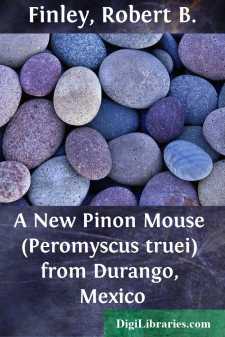Categories
- Antiques & Collectibles 13
- Architecture 36
- Art 48
- Bibles 22
- Biography & Autobiography 813
- Body, Mind & Spirit 142
- Business & Economics 28
- Children's Books 14
- Children's Fiction 11
- Computers 4
- Cooking 94
- Crafts & Hobbies 4
- Drama 346
- Education 46
- Family & Relationships 57
- Fiction 11828
- Games 19
- Gardening 17
- Health & Fitness 34
- History 1377
- House & Home 1
- Humor 147
- Juvenile Fiction 1873
- Juvenile Nonfiction 202
- Language Arts & Disciplines 88
- Law 16
- Literary Collections 686
- Literary Criticism 179
- Mathematics 13
- Medical 41
- Music 40
- Nature 179
- Non-Classifiable 1768
- Performing Arts 7
- Periodicals 1453
- Philosophy 64
- Photography 2
- Poetry 896
- Political Science 203
- Psychology 42
- Reference 154
- Religion 513
- Science 126
- Self-Help 84
- Social Science 81
- Sports & Recreation 34
- Study Aids 3
- Technology & Engineering 59
- Transportation 23
- Travel 463
- True Crime 29
A New Subspecies of Wood Rat (Neotoma mexicana) from Colorado
by: Robert B. Finley
Description:
Excerpt
Field and museum studies of the wood rats of Colorado have revealed the existence of an unnamed subspecies of Neotoma mexicana in eastern Colorado south of the Arkansas River. The characters of the new subspecies are most distinctive in the northeastern part of its range near Two Buttes and Higbee. It differs in cranial characters from N. m. fallax and N. m. inopinata and averages slightly larger, but cannot be distinguished by coloration of the pelage.
This heretofore undescribed subspecies may be known as:
Neotoma mexicana scopulorum subsp. nov.
Type.—Mus. Nat. Hist., Univ. Kansas, No. 37137, old adult male, skin and skull; from 37° 47' N, 103° 28' W, three miles northwest of Higbee, 4300 feet, Otero County, Colorado; trapped 16 May 1950 by R. B. Finley, Jr., original number 500516-1.
Range.—Cañons, mesas, and foothills south of the Arkansas River, east to Two Buttes, Colorado, and south to Clayton, New Mexico. The extent of the range to the southwest in New Mexico has not been determined.
Diagnosis.—Size large for the species; interorbital constriction near middle of frontal rather than anteriorly; supraorbital ridges of frontal concave laterally; skull large, strongly arched at base of rostrum; rostrum wide; nasals wide anteriorly; upper incisors wide, light yellow; molars large, tooth-rows long; zygomatic arches wide and heavy; interparietal short, wide, and posterior margin straight or with a slight posterior median angle.
Description.—Adults in dense unworn pelage taken in February at Two Buttes Reservoir: size large for the species; tail approximately 76 per cent as long as head and body; hind feet of medium length. Pelage: moderately long, thick; tail covered with short hairs; longest vibrissae 80 mm. Color: sides near Raffia (11 E 6) (capitalized color names and designators are of Maerz and Paul, A Dictionary of Color, McGraw-Hill Book Co., New York, 1930) overlaid with black, the general effect being grayish buff (13 G 6); back darker, moderately to heavily overlaid with black; indistinct dark eye ring; underparts whitish, fur basally gray except patch of fur pure white to base almost always present on upper throat; dark line around mouth; tail bicolor, black above, whitish below; feet white to ankles.
Skull: large for the species, strongly arched at base of rostrum; rostrum heavy; zygomatic arches widely spreading, heavy, squarish; braincase moderately ridged and angular; nasals wide anteriorly, lateral margins nearly parallel or converging evenly posteriorly, tapered abruptly at posterior ends which reach posteriorly beyond anterior plane of orbits; dorsal branches of premaxillae extending 0.5 to 1.2 mm. posterior to nasals; interorbital region moderately channeled, narrowly constricted near middle of frontal (instead of anteriorly); supraorbital ridges concave laterally, diverging more strongly posterior to interorbital constriction (frontal 8.7 to 9.5 mm. wide at posterior ends of supraorbital ridges); temporal ridges widely flaring on parietals; occipital ridges prominent; interparietal broadly rectangular between temporal ridges, usually short in median line of skull, posterior margin straight or with slight median posterior angle; incisive foramina tapered toward both ends, sometimes narrower anteriorly than posteriorly; anterior palatal spine usually forming a blade thickened on ventral edge, and right and left sides usually incompletely fused; nasal septum with a posterior notch separating vomer from maxillary; posterior margin of palate usually bearing single or double point, sometimes straight; interpterygoid fossa moderately wide, lateral margins concave; sphenopalatine vacuities large; auditory bullae of medium size; basioccipital with low median ridge or crest; upper incisors wide, yellow or yellow-orange; molars large, M1 wider than M2; maxillary tooth-rows long, nearly parallel; anterointernal fold of M1 deep, cutting more than half way across first enamel loop.
...


